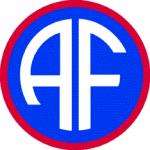Allied Force Headquarters
Allied Force Headquarters (AFHQ) was the headquarters that controlled all Allied operational forces in the Mediterranean Theatre of World War II from late 1942 until the end of the war in Europe in May 1945.

AFHQ was established in the United Kingdom in August 1942 under Lieutenant General Dwight David Eisenhower in order to command the forces committed to Operation Torch, the Allied invasion of French North Africa, set for November. Eisenhower had the title Commander-in-Chief, Allied Expeditionary Force. Shortly after the establishment of the headquarters, "Expeditionary" was deleted from its title, for reasons of operational security. Eisenhower thus became Commander-in-Chief, Allied Force.
Towards the end of 1942, there was a need to unify command of the Allied forces in North Africa, since those from the west, the British First Army, under the command of Lieutenant-General Kenneth Arthur Noel Anderson, landed during Operation Torch, and those from the east, the British Eighth Army, commanded by Lieutenant-General Bernard Law Montgomery, that had fought and won the Second Battle of El Alamein, were now close enough together to need coordination. Therefore, in February 1943, AFHQ assumed control of the Eighth Army advancing from the east as well.
Eisenhower remained in command of AFHQ until January 1944, overseeing the Allied invasion of Sicily (with the codename of Operation Husky), which began on 10 July 1943 and the Allied invasion of the Italian mainland (codenamed Operation Baytown and Operation Avalanche), on 3 September 1943. Eisenhower then a full general, returned to the United Kingdom in December to assume command of the Allied forces assembling for Operation Overlord, the Allied invasion of Normandy, scheduled for the spring of 1944. He was succeeded by General Sir Henry Maitland Wilson. Wilson's title became Supreme Commander, Mediterranean Theater of Operations.
Wilson was in command for just under a year, until he was sent to Washington, D.C. in December 1944 to replace Field Marshal Sir John Greer Dill of the British Joint Staff Mission who had died suddenly. Wilson was succeeded by Field Marshal Sir Harold Alexander who was Supreme Commander and commander of AFHQ until the end of the war. After the war AFHQ became a small interallied staff responsible for combined command liquidation activities and commanded by Lieutenant-General Sir William Duthie Morgan as Supreme Allied Commander Mediterranean.[1] AFHQ was abolished, effective 17 September 1947, by General Order 24, AFHQ, on 16 September 1947.
See also
- Mediterranean Theater of Operations (MTO) was originally called North African Theater of Operations (NATO) and is an American term for the conflict that took place between the Allies and Axis powers in North Africa and Italy during World War II.
References
- Mead, Richard (2007). Churchill's Lions: A biographical guide to the key British generals of World War II. Stroud (UK): Spellmount. p. 520. ISBN 978-1-86227-431-0.
External links
- History of AFHQ – Part One (August – December 1942)
- History of AFHQ – Part Two (December 1942 – December 1943)
- History of AFHQ – Part Three (December 1943 – July 1944)